Overview
- Brief Narrative
- Multi-colored, hand-knit sweater vest worn by Edmund Graf while imprisoned at Flossenbürg and Altenhammer concentration camps from August 4, 1944 to April 23, 1945. Germany invaded Poland in September 1939. In 1940, Edmund fled to Soviet occupied Lwow, but returned home after German invaded in June 1941. In December, he was sent to Pustkow slave labor camp. He was then transported to Mielec and Wieliczka slave labor camps and Flossenbürg and Altenhammer concentration camps, where he worked in airplane factories. On April 23, 1945 Edmund was liberated from Altenhammer by the US Army. Later, Edmund learned that his brother went to Palestine illegally in 1946 or 1947. The rest of Edmund’s family perished.
- Date
-
use:
approximately 1944 August-approximately 1945 April
- Geography
-
use:
Flossenbürg (Concentration camp);
Flossenbürg (Germany)
use: Altenhammer (Concentration camp); Altenhammer (Germany)
- Credit Line
- United States Holocaust Memorial Museum Collection, Gift of Edmund Graf
- Contributor
-
subject:
Edmund Graf
- Biography
-
Edmund Graf was born on August 12, 1919, in Lwow, Poland, (Lviv, Ukraine), to a Jewish couple. Edmund’s brother was born in 1914. In 1921, Edmund’s father was killed by Ukrainians. Not long after, Edmund’s mother took him and his brother to live with her parents in Dabrowa, Poland. As an adult, Edmund worked as an electrician.
In September 1939, Germany and the Soviet Union invaded Poland. Germany occupied regions west of the Bug River, the Soviet Union occupied those to the east. In October, Edmund was selected for forced labor and transported Dabrowa Tarnowska. In 1940, Edmund fled to Soviet occupied Lwow, where life was not as restricted for Jews. In June 1941, Germany occupied Lwow. Edmund began working for a company that produced mechanical equipment. One of the company’s German administrators learned that Edmund had the same surname as he did and threatened to kill Edmund. Edmund went back to Dabrowa. In December 1941, Edmund was taken to Pustkow labor camp, where he was a slave laborer alongside Soviet prisoners of war. In May 1942, he was sent to Mielec, a subcamp of Krakau-Płaszów slave labor camp, where he was a mechanic at the Ernst Heinkel Airplane factory. In January 1944, Krakau-Płaszów became a concentration camp with several official subcamps. On July 22, as the Soviet Army advanced on the region, Edmund was transported to Wieliczka, a subcamp of Krakau-Płaszów. Airplane production had been moved to the old, underground salt mine near this camp. Several days later, Edmund was deported to Flossenbürg concentration camp in Germany. He was issued prisoner number 14811 and a striped camp uniform. Edmund was assigned to the stitch detachment, as slave labor for the factories that built Messerschmitt 109, 110, and 111 fighter jets. The detachment was housed at Flossenbürg, but marched to nearby Altenhammer subcamp each day to work at the airplane factories. On April 8, 1945, Edmund was transferred to onsite barracks at Altenhammer. On April 23, he was liberated by US soldiers. Many civilians brought the former prisoners food, including potatoes, which kept Edmund alive.
On May 7, 1945, Germany surrendered. Edmund made his way to Auerbach and then settled in Hamburg. He contacted an uncle in Argentina, who was able to write to people in Dabrowa. All of Edmund’s relatives, except his brother, had been killed during the Holocaust. His brother had fought in a Polish division in the British Army during the war. In 1946 or 1947, he sailed to Palestine illegally aboard the ship Samaria and fought for Israeli Independence. In August 1950, Edmund boarded USNS General W.H. Haan and went to the United States. Edmund married a fellow Holocaust survivor, Malvina Kleinberger. Malvina was born on December 19, 1922, in Krakow, Poland, to Jacob and Leontyna Geiger Kleinberger. She had 7 siblings: Balbina, Sabina, Maria, Henryk, Szymon, Helena, and a sister who died pre-war. In September 1939, Malvina fled to Soviet occupied Lvov, but later returned to Krakow ghetto. In January 1943, she was interned at Krakau-Płaszów slave labor camp, and then at Auschwitz, Bergen-Belsen, and Burgau concentration camps. In April 1945, Malvina was marched from Burgau, a Dachau subcamp, to Allach, where she was liberated by US soldiers. In December 1947, Malvina and her surviving siblings, Balbina Sabina, and Maria went to the US. Henryk and his wife came over a few years later. Edmund and Malvina settled in Brooklyn and had three daughters. Malvina, 84, died on November 26, 2007. Edmund, 93, died on August 18, 2012.
Physical Details
- Classification
-
Clothing and Dress
- Category
-
Men's clothing
- Object Type
-
Vests (lcsh)
- Physical Description
- Man’s hand knitted, wool yarn sweater vest with green rib stitched trim, a V-shaped neckline, and a horizontal, striped, checkerboard pattern in blue, green, brown, gray, and yellow tones. There is a wide, green panel on the shoulders. The side seams are handsewn with green yarn. Dark blue, rib stitched trim is sewn to the waistband. There are small losses and discoloration throughout.
- Dimensions
- overall: Height: 19.750 inches (50.165 cm) | Width: 14.125 inches (35.878 cm)
- Materials
- overall : yarn
Rights & Restrictions
- Conditions on Access
- No restrictions on access
- Conditions on Use
- No restrictions on use
Keywords & Subjects
Administrative Notes
- Legal Status
- Permanent Collection
- Provenance
- The sweater vest was donated to the United States Holocaust Memorial Museum in 1994 by Edmund Graf.
- Funding Note
- The cataloging of this artifact has been supported by a grant from the Conference on Jewish Material Claims Against Germany.
- Record last modified:
- 2024-08-07 12:49:53
- This page:
- https://collections.ushmm.org/search/catalog/irn8727
Download & Licensing
In-Person Research
- By Appointment
- Request 21 Days in Advance of Visit
- Plan a Research Visit
- Request to See This Object
Contact Us
Also in Edmund Graf collection
The collection consists of a concentration camp uniform, soap, a sweater, and a shirt relating to the experiences of Edmund Graf after he was deported from Poland to Flossenburg and Altenhammer concentration camps during the Holocaust.
Date: approximately 1944 August-approximately 1945
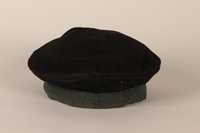
Black cap worn by a Polish Jewish concentration camp inmate
Object
Black wool civilian cap worn as a concentration camp uniform cap by Edmund Graf while imprisoned at Flossenbürg and Altenhammer concentration camps from August 4, 1944 to April 23, 1945. Germany invaded Poland in September 1939. In 1940, Edmund fled to Soviet occupied Lwow, but returned home after Germany invaded in June 1941. In December, he was sent to Pustkow slave labor camp. He was then transported to Mielec and Wieliczka slave labor camps and Flossenbürg and Altenhammer concentration camps, where he worked in airplane factories. On April 23, 1945 Edmund was liberated from Altenhammer by the US Army. Later, Edmund learned that his brother went to Palestine illegally in 1946 or 1947. The rest of Edmund’s family perished.
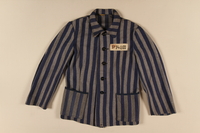
Concentration camp uniform jacket with red triangle worn by a Polish Jewish inmate
Object
Striped concentration camp uniform jacket worn by Edmund Graf while imprisoned at Flossenbürg and Altenhammer concentration camps from August 4, 1944 to April 23, 1945. The white cloth patch with his prisoner number P 14811, and an inverted, red triangle, identifying him as a political prisoner were given to him by a friend who worked in the camp’s tailor shop. Germany invaded Poland in September 1939. In 1940, Edmund fled to Soviet occupied Lwow, but returned home after German invaded in June 1941. In December, he was sent to Pustkow slave labor camp. He was then transported to Mielec and Wieliczka slave labor camps and Flossenbürg and Altenhammer concentration camps, where he worked in airplane factories. On April 23, 1945 Edmund was liberated from Altenhammer by the US Army. Later, Edmund learned that his brother went to Palestine illegally in 1946 or 1947. The rest of Edmund’s family perished.
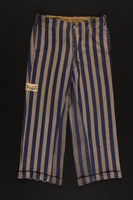
Concentration camp uniform pants with red triangle patch worn by Polish Jewish inmate
Object
Striped concentration camp uniform trousers worn by Edmund Graf while imprisoned at Flossenbürg and Altenhammer concentration camps from August 4, 1944 to April 23, 1945. The white cloth patch with his prisoner number P 14811, and an inverted, red triangle, identifying him as a political prisoner was given to him by a friend who worked in the camp’s tailor shop. Germany invaded Poland in September 1939. In 1940, Edmund fled to Soviet occupied Lwow, but returned home after Germany invaded in June 1941. In December, he was sent to Pustkow slave labor camp. He was then transported to Mielec and Wieliczka slave labor camps and Flossenbürg and Altenhammer concentration camps, where he worked in airplane factories. On April 23, 1945 Edmund was liberated from Altenhammer by the US Army. Later, Edmund learned that his brother went to Palestine illegally in 1946 or 1947. The rest of Edmund’s family perished.
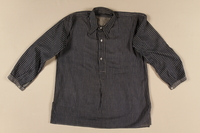
Striped uniform shirt worn by a Polish Jewish concentration camp inmate
Object
Loose fitting blue shirt with white pinstripes worn by Edmund Graf while imprisoned at Flossenbürg and Altenhammer concentration camps from August 4, 1944 to April 23, 1945. Germany invaded Poland in September 1939. In 1940, Edmund fled to Soviet occupied Lwow, but returned home after German invaded in June 1941. In December, he was sent to Pustkow slave labor camp. He was then transported to Mielec and Wieliczka slave labor camps and Flossenbürg and Altenhammer concentration camps, where he worked in airplane factories. On April 23, 1945 Edmund was liberated from Altenhammer by the US Army. Later, Edmund learned that his brother went to Palestine illegally in 1946 or 1947. The rest of Edmund’s family perished.
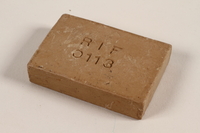
Bar of soap issued to a Polish Jewish concentration camp inmate
Object
Bar of brown, waxy soap issued to Edmund Graf while imprisoned at Flossenbürg and Altenhammer concentration camps from August 4, 1944 to April 23, 1945. When Edmund was handed the soap, he was told that it had been made from the “remains of Jewish victims,” but this rumor was not true. Germany invaded Poland in September 1939. In 1940, Edmund fled to Soviet occupied Lwow, but returned home after German invaded in June 1941. In December, he was sent to Pustkow slave labor camp. He was then transported to Mielec and Wieliczka slave labor camps and Flossenbürg and Altenhammer concentration camps, where he worked in airplane factories. On April 23, 1945 Edmund was liberated from Altenhammer by the US Army. Later, Edmund learned that his brother went to Palestine illegally in 1946 or 1947. The rest of Edmund’s family perished.



